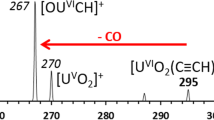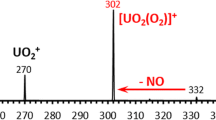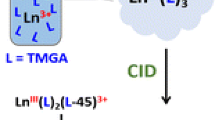Abstract
The exothermic and barrierless activation of CO2 by the lanthanide gadolinium cation (Gd+) to form GdO+ and CO is investigated in detail using guided ion beam tandem mass spectrometry (GIBMS) and theory. Kinetic energy dependent product ion cross sections from collision-induced dissociation (CID) experiments of GdCO2 + are measured to determine the energetics of OGd+(CO) and Gd+(OCO) intermediates. Modeling these cross sections yields bond dissociation energies (BDEs) for OGd+–CO and Gd+–OCO of 0.57 ± 0.05 and 0.38 ± 0.05 eV, respectively. The OGd+–CO BDE is similar to that previously measured for Gd+–CO, which can be attributed to the comparable electrostatic interaction with CO in both complexes. The Gd+(OCO) adduct is identified from calculations to correspond to an electronically excited state. The thermochemistry here and the recently measured GdO+ BDE allows for the potential energy surface (PES) of the Gd+ reaction with CO2 to be deduced from experiment in some detail. Theoretical calculations are performed for comparison with the experimental thermochemistry and for insight into the electronic states of the GdCO2 + intermediates, transition states, and the reaction mechanism. Although the reaction between ground state Gd+ (10D) and CO2 (1Σg +) reactants to form ground state GdO+ (8Σ−) and CO (1Σ+) products is formally spin-forbidden, calculations indicate that there are octet and dectet surfaces having a small energy gap in the entrance channel, such that they can readily mix. Thereby, the reaction can efficiently proceed along the lowest energy octet surface to yield ground state products, consistent with the experimental observations of an efficient, barrierless process. At high collision energies, the measured GdO+ cross section from the Gd+ reaction with CO2 exhibits a distinct feature, attributed to formation of electronically excited GdO+ products along a single dectet PES in a diabatic and spin-allowed process. Modeling this high-energy feature gives an excitation energy of 3.25 ± 0.16 eV relative to the GdO+ (8Σ−) ground state, in good agreement with calculated excitation energies for GdO+ (10Π, 10Σ−) electronic states. The reactivity of Gd+ with CO2 is compared with the group 3 transition metal cations and other lanthanide cations and periodic trends are discussed.









Similar content being viewed by others
References
Sakakura T, Choi J-C, Yasuda H (2007) Chem Rev 107:2365–2387
Cokoja M, Bruckmeier C, Rieger B, Herrmann WA, Kühn FE (2011) Angew Chem Int Ed 50:8510–8537
Appel AM, Bercaw JE, Bocarsly AB, Dobbek H, DuBois DL, Dupuis M, Ferry JG, Fujita E, Hille R, Kenis PJA, Kerfeld CA, Morris RH, Peden CHF, Portis AR, Ragsdale SW, Rauchfuss TB, Reek JNH, Seefeldt LC, Thauer RK, Waldrop GL (2013) Chem Rev 113:6621–6658
Schwarz H (2017) Coord Chem Rev 334:112–123
Irikura KK, Beauchamp JL (1991) J Phys Chem 95:8344–8351
Wesendrup R, Schwarz H (1995) Angew Chem Int Ed Engl 34:2033–2035
Kappes MM, Staley RH (1981) J Phys Chem 85:942–944
Kappes MM, Staley RH (1981) J Am Chem Soc 103:1286–1287
Cheng P, Koyanagi GK, Bohme DK (2006) J Phys Chem A 110:12832–12838
Dheandhanoo S, Chatterjee BK, Johnsen R (1985) J Chem Phys 83:3327–3329
Koyanagi GK, Bohme DK (2006) J Phys Chem A 110:1232–1241
Armentrout PB (2002) J Am Soc Mass Spectrom 13:419–434
Armentrout PB (2000) Int J Mass Spectrom 200:219–241
Sievers MR, Armentrout PB (1995) J Chem Phys 102:754–762
Griffin JB, Armentrout PB (1997) J Chem Phys 107:5345–5355
Griffin JB, Armentrout PB (1998) J Chem Phys 108:8062–8074
Rodgers MT, Walker B, Armentrout PB (1999) Int J Mass Spectrom 182–183:99–120
Sievers MR, Armentrout PB (1998) Int J Mass Spectrom 179–180:103–115
Sievers MR, Armentrout PB (1999) Inorg Chem 38:397–402
Sievers MR, Armentrout PB (1999) Int J Mass Spectrom 185–187:117–129
Sievers MR, Armentrout PB (1998) J Phys Chem A 102:10754–10762
Zhang X-G, Armentrout PB (2003) J Phys Chem A 107:8904–8914
Clemmer DE, Weber ME, Armentrout PB (1992) J Phys Chem 96:10888–10893
Armentrout PB, Cox RM (2017) Phys Chem Chem Phys 19:11075–11088
Armentrout PB, Beauchamp JL (1980) Chem Phys 50:27–36
Campbell ML (1999) Phys Chem Chem Phys 1:3731–3735
Schofield K (2006) J Phys Chem A 110:6938–6947
Ard SG, Shuman NS, Martinez O, Brumbach MT, Viggiano AA (2015) J Chem Phys 143:204303
Konings RJM, Beneš O, Kovács A, Manara D, Sedmidubský D, Gorokhov L, Iorish VS, Yungman V, Shenyavskaya E, Osina E (2014) J Phys Chem Ref Data 43:013101
Ard SG, Shuman NS, Martinez O, Armentrout PB, Viggiano AA (2016) J Chem Phys 145:084302
Gibson JK (2003) J Phys Chem A 107:7891–7899
Dai G-L, Wang C-F (2009) J Mol Struct 909:122–128
Wang Y-C, Yang X-y, Geng Z-Y, Liu Z-Y (2006) Chem Phys Lett 431:39–44
Wang Y-C, Liu H-W, Geng Z-Y, Lv L-L, Si Y-B, Wang Q-Y, Wang Q, Cui D-D (2011) Int J Quantum Chem 111:2021–2030
Schröder D, Shaik S, Schwarz H (2000) Acc Chem Res 33:139–145
Demireva M, Kim J, Armentrout PB (2016) J Phys Chem A 120:8550–8563
Loh SK, Hales DA, Lian L, Armentrout PB (1989) J Chem Phys 90:5466–5485
Ervin KM, Armentrout PB (1985) J Chem Phys 83:166–189
Schultz RH, Crellin KC, Armentrout PB (1991) J Am Chem Soc 113:8590–8601
Daly NR (1960) Rev Sci Instrum 31:264–267
Muntean F, Armentrout PB (2001) J Chem Phys 115:1213–1228
Weber ME, Elkind JL, Armentrout PB (1986) J Chem Phys 84:1521–1529
Frisch MJ, Trucks GW, Schlegel HB, Scuseria GE, Robb MA, Cheeseman JR, Scalmani G, Barone V, Mennucci B, Petersson GA, Nakatsuji H, Caricato M, Li X, Hratchian HP, Izmaylov AF, Bloino J, Zheng G, Sonnenberg JL, Hada M, Ehara M, Toyota K, Fukuda R, Hasegawa J, Ishida M, Nakajima T, Honda Y, Kitao O, Nakai H, Vreven T, Montgomery JA Jr, Peralta JE, Ogliaro F, Bearpark MJ, Heyd J, Brothers EN, Kudin KN, Staroverov VN, Kobayashi R, Normand J, Raghavachari K, Rendell AP, Burant JC, Iyengar SS, Tomasi J, Cossi M, Rega N, Millam NJ, Klene M, Knox JE, Cross JB, Bakken V, Adamo C, Jaramillo J, Gomperts R, Stratmann RE, Yazyev O, Austin AJ, Cammi R, Pomelli C, Ochterski JW, Martin RL, Morokuma K, Zakrzewski VG, Voth GA, Salvador P, Dannenberg JJ, Dapprich S, Daniels AD, Farkas Ö, Foresman JB, Ortiz JV, Cioslowski J, Fox DJ (2009) Gaussian 09, Gaussian, Inc., Wallingford
Becke AD (1993) J Chem Phys 98:5648–5652
Lee C, Yang W, Parr RG (1988) Phys Rev B 37:785–789
Dolg M, Stoll H, Preuss H (1989) J Chem Phys 90:1730–1734
Cao X, Dolg M (2001) J Chem Phys 115:7348–7355
Perdew JP, Ernzerhof M, Burke K (1996) J Chem Phys 105:9982–9985
Adamo C, Barone V (1999) J Chem Phys 110:6158–6170
Raghavachari K, Trucks GW, Pople JA, Head-Gordon M (1989) Chem Phys Lett 157:479–483
Bartlett RJ, Watts JD, Kucharski SA, Noga J (1990) Chem Phys Lett 165:513–522
Scuseria GE, Lee TJ (1990) J Chem Phys 93:5851–5855
Crawford TD, Stanton JF (1998) Int J Quantum Chem 70:601–611
Douglas M, Kroll NM (1974) Ann Phys 82:89–155
Reiher M, Wolf A (2004) J Chem Phys 121:10945–10956
Lu Q, Peterson KA (2016) J Chem Phys 145:054111
Foresman JB, Frisch A (1996) Exploring Chemistry with Electronic Structure Methods. Gaussian, Pittsburgh
Schuchardt KL, Didier BT, Elsethagen T, Sun L, Gurumoorthi V, Chase J, Li J, Windus TL (2007) J Chem Inf Model 47:1045–1052
Feller D (1996) J Comput Chem 17:1571–1586
Gioumousis G, Stevenson DP (1958) J Chem Phys 29:294–299
Koyanagi GK, Bohme DK (2001) J Phys Chem A 105:8964–8968
Darwent Bd (1970) Bond Dissociation Energies in Simple Molecules. NSRDS-NBS31, 4:48
Chesnavich WJ, Bowers MT (1979) J Phys Chem 83:900–905
Hinton CS, Citir M, Manard M, Armentrout PB (2011) Int J Mass Spectrom 308:265–274
Demireva M, Armentrout PB (2017) J Chem Phys 146:174302
Burley JD, Ervin KM, Armentrout PB (1987) Int J Mass Spectrom Ion Processes 80:153–175
Armentrout PB (2013) J Chem Phys 139:084305
Hinton CS, Citir M, Armentrout PB (2013) Int J Mass Spectrom 354–355:87–98
Kretzschmar I, Schröder D, Schwarz H, Rue C, Armentrout PB (1998) J Phys Chem A 102:10060–10073
Rue C, Armentrout PB, Kretzschmar I, Schröder D, Harvey JN, Schwarz H (1999) J Chem Phys 110:7858–7870
Shaik S (2013) Int J Mass Spectrom 354–355:5–14
Harris N, Shaik S, Schröder D, Schwarz H (1999) Helv Chim Acta 82:1784–1797
Rodgers MT, Armentrout PB (2007) Int J Mass Spectrom 267:167–182
Martin JML (1996) Chem Phys Lett 259:669–678
Cox RM, Kim J, Armentrout PB, Bartlett J, VanGundy RA, Heaven MC, Ard SG, Melko JJ, Shuman NS, Viggiano AA (2015) J Chem Phys 142:134307
Acknowledgements
The authors thank the U.S. Air Force Office of Scientific Research (FA9550-16-1-0095) for financial support, Professor Kirk A. Peterson for providing the all-electron basis sets, and the Center for High Performance Computing at the University of Utah for generous allocation of computer time. Additionally, some of the more computationally demanding calculations were performed on the large shared-memory cluster at the Pittsburgh Supercomputing Center at Carnegie Mellon University via the Extreme Science and Engineering Discovery Environment (XSEDE), under grant number TG-CHE170012. Christopher McNary is thanked for help with using these resources.
Author information
Authors and Affiliations
Corresponding author
Electronic supplementary material
Below is the link to the electronic supplementary material.
Rights and permissions
About this article
Cite this article
Demireva, M., Armentrout, P.B. Activation of CO2 by Gadolinium Cation (Gd+): Energetics and Mechanism from Experiment and Theory. Top Catal 61, 3–19 (2018). https://doi.org/10.1007/s11244-017-0858-1
Published:
Issue Date:
DOI: https://doi.org/10.1007/s11244-017-0858-1




